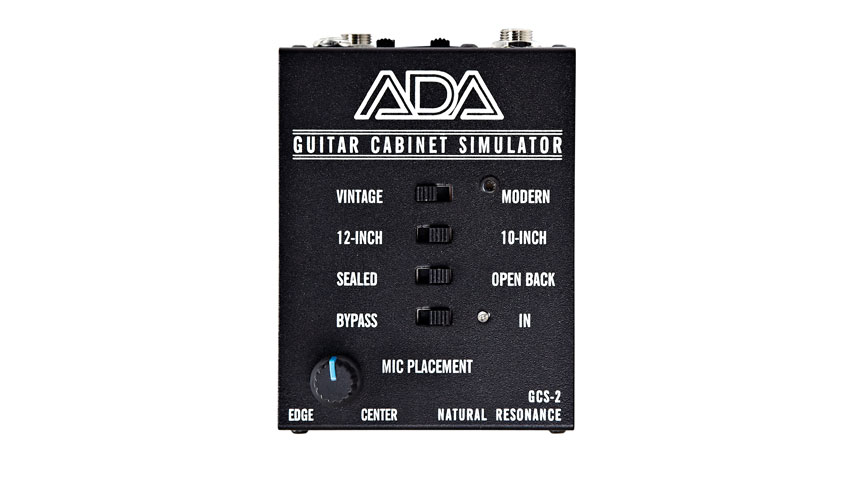MusicRadar Verdict
An inexpensive box that's practical in several different scenarios, and can recreate the sound of a range of guitar speaker cabinets.
Pros
- +
Useful range of cabinet/speaker types emulated. Good connectivity. Variable mic placement.
Cons
- -
Not a lot.
MusicRadar's got your back
The A/DA GCS-2 is a guitar cabinet simulator and DI box that uses a purely analogue circuit design. So, why would you want to simulate a guitar cabinet? Well, several reasons spring to mind, notably in live performance…
"If you can't use speaker cabinets on stage, a speaker simulator can supply a signal that's sonically close to the sound of a mic'd cab"
If, for any reason, you can't or don't want to use speaker cabinets on stage, a speaker simulator connected from your pedalboard can supply a signal that's sonically close to the sound of a mic'd cab to the front-of-house sound system and the onstage monitors.
Or you may be using an amp on stage and want to send an unadulterated signal rather than one from a mic'd cabinet, perhaps for a consistent signal through in-ear monitors. This can be done by taking the signal from an amp's preamp output.
Another scenario may be for recording, where it's not possible to mic up a speaker cab - a speaker simulator could be fed from an amp, from a dedicated guitar preamp (such as A/DA's own APP-1), or from an overdrive or distortion pedal. Furthermore, a guitar through an amp that's double-tracked with a microphone and a speaker simulator will give more options when mixing.
The cabinet simulator on test is a compact stompbox-sized unit with connections round the back and four two-way switches plus a single knob on the top surface. The unit takes an input through a standard jack, while there are outputs on XLR and jack for the speaker-simulated signal plus a Pass Thru output that can send a split of the input signal directly to your amp.
"You have a choice of vintage or modern and 10- or 12-inch speaker simulations, as well as open-back or sealed cabinet models"
There are several options for creating the type of cabinet sound that you want. You have a choice of vintage or modern speaker: vintage represents an Alnico magnet-based model like an early Jensen, while modern is based on a ceramic model like a Celestion Greenback or an Eminence.
The second choice is for a 10- or 12-inch speaker and the tonal response that implies. You can also select an open-back or sealed (closed-back) cabinet. The final tweak comes courtesy of a rotary knob simulating mic placement in front of a speaker, running from edge to centre.
Want all the hottest music and gear news, reviews, deals, features and more, direct to your inbox? Sign up here.
In Use
"Recording an overdrive pedal direct to a mixing desk with the GCS-2 switched in, the difference was truly remarkable"
Our first test of the GCS-2 was to do some recording using just an overdrive pedal. With the GCS-2 bypassed, the sound was the wasp-in-a-jam-jar buzzfest you'd expect when connecting a pedal direct to a mixing desk. But with the GCS-2 switched in, the difference was truly remarkable, with the circuitry completely taming the top end and sounding very close to a mic'd speaker cab.
The three two-way switches yield eight different combinations that offer flavours of the real thing. The vintage speaker sound has a certain warmth, while the modern sound delivers more edgy top-end presence. Likewise, the 12-inch speaker option provides more low-end than the sparkier 10-inch.
A/DA says that its Natural Resonance Response technology replicates the low-frequency natural resonance of a guitar speaker cabinet at loud volumes, and the sealed cabinet setting does seem to nail that extra low-end projection typical of a 4x12 cab, which isn't there in the open-back.
Once you've selected the combination that works best for you, it's time for the mic placement knob to do the final adjustments. It does a really good job of reproducing the sonic variation that placing the mic at different points across the speaker's axis makes, with a full treble response at the centre that decreases as you move towards the edge.
If there is one thing to note with the GCS-2, it's that it doesn't feature a power soak/ load box, so you can't connect it to a valve amp's speaker output (there are other options such as the Palmer PDI-03 if you want to do that), but for all of the roles mentioned earlier it does a great job. In fact, for a small outlay, the GCS-2 is one very useful piece of gear. It can provide plenty of variation on the mic'd cab sound without a microphone in sight.
Trevor Curwen has played guitar for several decades – he's also mimed it on the UK's Top of the Pops. Much of his working life, though, has been spent behind the mixing desk, during which time he has built up a solid collection of the guitars, amps and pedals needed to cover just about any studio session. He writes pedal reviews for Guitarist and has contributed to Total Guitar, MusicRadar and Future Music among others.

